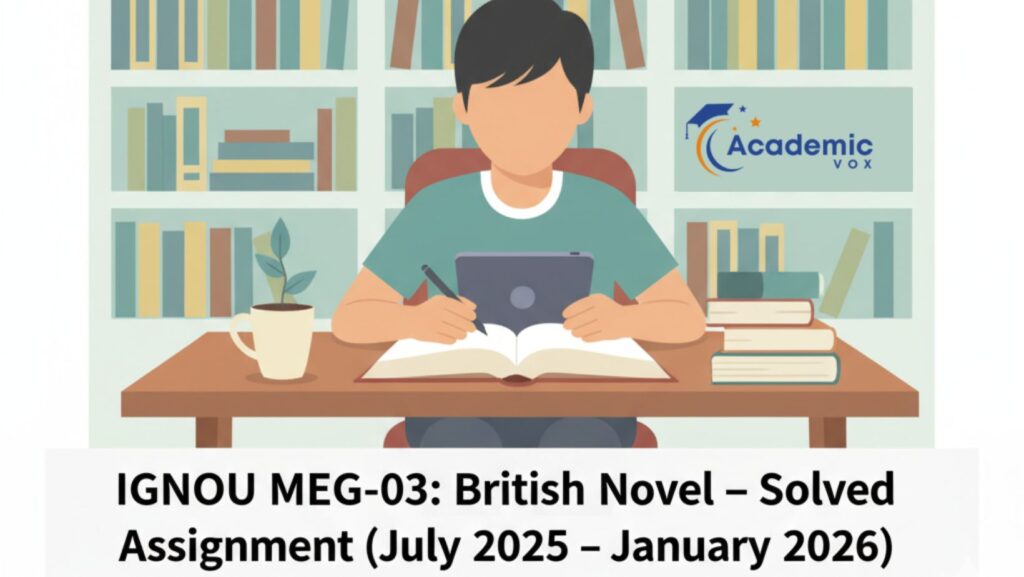IGNOU MEG-03: British Novel – Solved Assignment (July 2025 – January 2026)

Introduction
The IGNOU Master of Arts in English (MEG) course is meant to provide students with a thorough grasp of literature, literary theory, and critical perspectives. Among the significant courses, MEG-03: British Novel occupies a prime position. It tracks the history of the British novel from its primitive beginnings to contemporary masterpieces, tracing the themes, narrative modes, historical backgrounds, and the works of celebrated writers.
This blog offers the solved assignment of MEG-03 (July 2025 – January 2026 session). Prepared in academic but easy language, this solved guide will assist IGNOU students in preparing high-quality responses, understanding British fiction deeply, and achieving good marks in their assessments.
About IGNOU MEG-03: British Novel
- Course Code: MEG-03
- Course Title: British Novel
- Program: MA English (MEG)
- Assignment Session: July 2025 – January 2026
- Assignment Type: Tutor Marked Assignment (TMA)
The paper assists students in learning: - The emergence and development of the English novel.
- Notable themes and narrative strategies.
- Texts of writers such as Henry Fielding, Charles Dickens, George Eliot, Thomas Hardy, and others.
- How the British novel portrays society, culture, and politics.
Significance of MEG-03 in IGNOU MA English
- Enhances analytical and interpretative abilities.
- Assists students in appreciating the historical context of literary writing.
- Prepares students for research at the academic level, teaching, and literary criticism.
- Refines critical reading and writing skills.
IGNOU MEG-03 Solved Assignment (July 2025 – January 2026)
Here are sample question-wise answers in a well-structured, exam-ready format.
(Note: Real IGNOU questions will be different – this is a reference draft.)
Question 1: Discuss the Rise of the English Novel in the 18th Century.
Answer:
The 18th century saw the birth of the English novel as a literary genre. Novelists such as Daniel Defoe, Samuel Richardson, and Henry Fielding moulded the novel into a formalized presentation of daily life and psychology of man.
- Defoe initiated realism with Robinson Crusoe.
- Richardson developed the epistolary novel in Pamela, emphasizing sentiment and moral problems.
- Fielding provided satire and comic realism in Tom Jones.
The middle-class growth, print culture, and social change made the novel a bestseller.
Question 2: Critically Analyze Charles Dickens as a Social Reformer through His Novels.
Answer:
Charles Dickens employed fiction as a weapon of social critique. Through his novels, Dickens revealed the reality of industrial society, poverty, children’s labor, and class disparity.
- Oliver Twist reflects the exploitation of orphans.
- Hard Times criticizes utilitarianism and the dehumanizing impact of industrialization.
- David Copperfield depicts personal struggle and social mobility.
Through dramatic storylines and vivid characters, Dickens became a storyteller and a reformer.
Question 3: Analyze the Feminist Issues in George Eliot’s Novels.
Answer:
George Eliot (Mary Ann Evans) examined gender roles and women’s challenges in Victorian society.
- The Mill on the Floss depicts Maggie Tulliver’s conflict between obligation and personal desire.
- Middlemarch focuses on the intellectual desires of women through Dorothea Brooke.
- Eliot denounces the limited prospects for women and promotes moral strength, compassion, and learning.
Her realistic presentation made her a forerunner of feminist thinking in English literature.
Question 4: How Does Thomas Hardy Represent Fate and Tragedy in His Novels?
Answer:
Hardy’s novels tend to mirror a pessimistic view of the world, in which the life of man is governed by fate, social norms, and natural forces.
- Tess of the D’Urbervilles portrays Tess as a tragic heroine ruined by social hypocrisy and fate.
- Jude the Obscure satirizes class divisions and the stern education system.
- Hardy merges realism with fatalism, proposing that human will is usually helpless against greater powers.
His novels mix rural environments with universal concerns of anguish and survival.
Question 5: Comment on the Narrative Techniques in the British Novel.
Answer:
The British novel has developed by way of different narrative techniques:
- Epistolary Form – Richardson’s Pamela.
- Omniscient Narrator – Fielding and Dickens.
- Stream of Consciousness – Virginia Woolf, James Joyce.
- Realism and Psychological Depth – George Eliot, Hardy.
These methods enabled novelists to play with form, to represent subjectivity, and to involve readers intensely.
Challenges in Studying the British Novel
- Complex historical contexts.
- Lengthy narratives requiring close reading.
- Use of symbolism and allegory.
- Changes in language style from 18th to 20th century.
Tips for IGNOU MEG-03 Students
- Study original novels in parallel with summaries.
- Organize answers with introduction, analysis, and conclusion.
- Make use of critical references (e.g., F.R. Leavis, Raymond Williams).
- Compare authors through periods for deeper insights.
- Do not memorize by rote—concentrate on interpretation.
Conclusion
The IGNOU MEG-03 British Novel assignment (July 2025 – January 2026) provides students with an in-depth understanding of the development of the English novel, ranging from its realistic origins to its experimental contemporary configurations. Through the study of key writers, narrative forms, and thematic issues, students acquire academic and critical abilities required in advanced studies of literature.
This solved assignment is written as a guide of reference to assist IGNOU MA English students in preparing well-formatted, analytical, and exam-ready responses.
